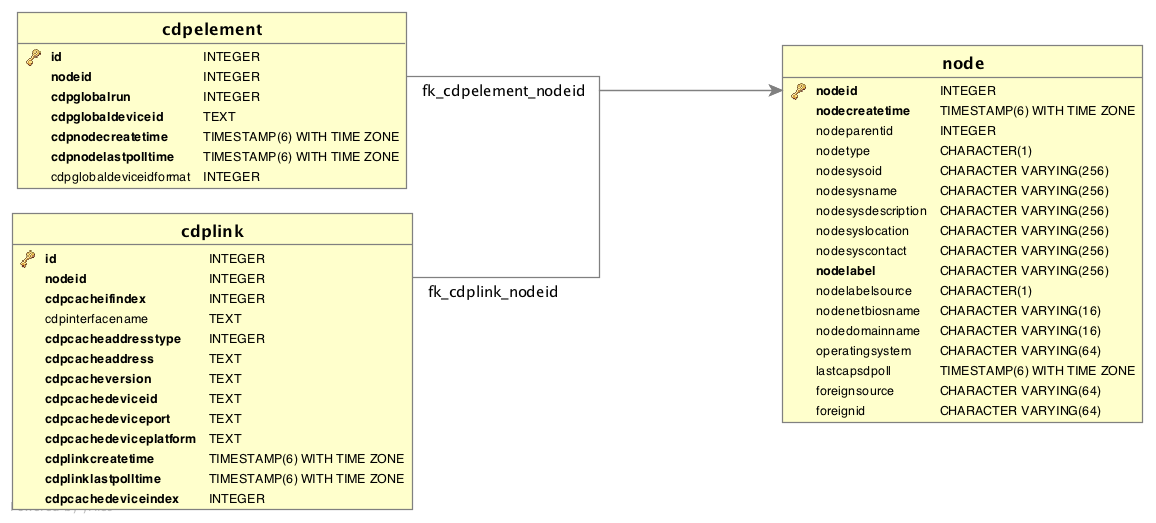Cisco Discovery Protocol
The Cisco Discovery Protocol (CDP) is a proprietary link layer protocol developed by Cisco. Network devices use the protocol to advertise their identities, capabilities, and neighbors.
CDP functions similarly to several proprietary protocols, such as the Link Layer Discovery Protocol (LLDP), Extreme Discovery Protocol (EDP), Foundry Discovery Protocol (FDP), Nortel Discovery Protocol (also known as SONMP), and Microsoft’s Link Layer Topology Discovery (LLTD) protocol.
CDP uses information that the CISCO-CDP-MIB and CISCO-VTP-MIB modules provide. You can find generic information about the CDP process in the CDP Information box on any device’s Node Detail page.
CDP Topology Updater
The CDP Topology Updater consolidates data from the CDP Collector and provides it to the CDP OnmsTopology. Only full bidirectional connections between two CDP-supported devices become edges in the topology. For example, Node A and Node B are connected by a CDP edge if, and only if, there is a CDP MIB port connection from Node A to Node B, and vice versa.
Only nodes with a running CDP process can be part of the link discovery process.
The data collected is similar to that displayed by running the show cdp neighbor command on a device’s command line.
Linux and Windows servers do not have a CDP process running by default, and will not be part of the link discovery process.
|
Information gathered from supported OIDs is stored in the following database tables:

Supported OIDs
The following OIDs are supported for the discovery and construction of the CDP network topology. The CDP Discovery Collector collects them:
| Name | Description | OID |
|---|---|---|
ifDescr |
Text string that contains information about the interface. This string should include the name of the manufacturer, the product name, and the version of the interface hardware or software. |
.1.3.6.1.2.1.2.2.1.2 |
| Name | Description | OID |
|---|---|---|
cdpInterfaceName |
Name of the local interface as advertised by CDP in the Port-ID TLV. |
.1.3.6.1.4.1.9.9.23.1.1.1.1.6 |
cdpCacheEntry |
An entry in the |
.1.3.6.1.4.1.9.9.23.1.2.1.1 |
cdpCacheAddressType |
Type of address contained in the corresponding instance of |
.1.3.6.1.4.1.9.9.23.1.2.1.1.3 |
cdpCacheAddress |
The first network-layer address of the device’s |
.1.3.6.1.4.1.9.9.23.1.2.1.1.4 |
cdpCacheVersion |
|
.1.3.6.1.4.1.9.9.23.1.2.1.1.5 |
cdpCacheDeviceId |
|
.1.3.6.1.4.1.9.9.23.1.2.1.1.6 |
cdpCacheDevicePort |
|
.1.3.6.1.4.1.9.9.23.1.2.1.1.7 |
cdpCachePlatform |
Device’s hardware platform, as reported in the most recent CDP message.
A zero-length string indicates that no |
.1.3.6.1.4.1.9.9.23.1.2.1.1.8 |
cdpGlobalRun |
CDP status.
Entries in |
.1.3.6.1.4.1.9.9.23.1.3.1.0 |
cdpGlobalDeviceId |
Device ID advertised by this device.
Its format is characterized by the value of |
.1.3.6.1.4.1.9.9.23.1.3.4.0 |
cdpGlobalDeviceIdFormat |
Format of the |
.1.3.6.1.4.1.9.9.23.1.3.7.0 |
| Name | Description | OID |
|---|---|---|
vtpVersion |
Version of VTP in use on the local system.
A device will report its version capability and not any particular version in use on the device.
If the device does not support VTP, the version is |
.1.3.6.1.4.1.9.9.46.1.1.1.0 |
ciscoVtpVlanState |
State of the VLAN. |
.1.3.6.1.4.1.9.9.46.1.3.1.1.2 |
ciscoVtpVlanType |
VLAN type ( |
.1.3.6.1.4.1.9.9.46.1.3.1.1.3 |
ciscoVtpVlanName |
Name of the VLAN.
This OID is used as the |
.1.3.6.1.4.1.9.9.46.1.3.1.1.4 |